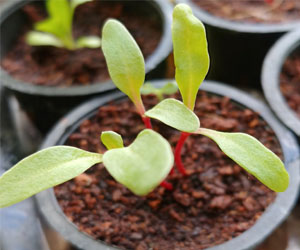


The Art Of Seasonal Planting

Gardening, like life itself, follows a rhythmic cycle of seasons, each offering its unique charm and challenges. Seasonal planting is a fundamental practice that aligns your garden with nature's calendar, ensuring that the right plants grow at the right time. In this article, we will explore the benefits of seasonal planting and provide guidance on how to plan and execute a successful seasonal garden.
The Importance Of Seasonal Planting
Seasonal planting is more than just a tradition; it is a science and an art that has been practiced for generations. It recognizes the fact that different plants thrive in different seasons due to variations in temperature, daylight, and weather conditions. By aligning your garden with these natural rhythms, you can optimize plant growth, health, and yield.
Key Benefits Of Seasonal Planting
Optimal Growth Conditions: Seasonal planting ensures that your crops receive the right balance of sunlight, temperature, and moisture at each stage of their growth. This leads to healthier and more productive plants.
Crop Diversity: Planting seasonally allows you to diversify your garden throughout the year. Different seasons support various plant families, from cool-season greens in spring to warm-season fruits in summer.
Pest And Disease Management: Seasonal changes can disrupt the life cycles of garden pests and pathogens. By rotating your crops seasonally, you reduce the risk of infestations.
Soil Health: Seasonal planting helps maintain soil fertility by preventing the depletion of specific nutrients. Different plants have varying nutrient needs, and rotating them can help your soil recover.
Planning A Seasonal Garden
Know Your Climate: Understand your local climate, including temperature ranges, rainfall patterns, and frost dates. This information is essential for determining which plants thrive in your area during each season.
Create A Planting Calendar: Design a planting calendar that outlines what to plant and when. Consider the average date of the last spring frost and the first fall frost, as these are crucial markers for selecting plants.
Crop Selection: Choose crops that are well-suited to each season. For example, plant cool-season vegetables like lettuce and spinach in spring and heat-loving tomatoes and peppers in summer.
Succession Planting: Plan for successive plantings of certain crops to ensure a continuous harvest. For example, sow beans every few weeks to enjoy a prolonged supply.
Tips For Success In Seasonal Planting
Garden Layout: Organize your garden in a way that takes advantage of varying light and temperature conditions. Taller plants can provide shade to more delicate ones during scorching summers.
Soil Preparation: Properly prepare your soil before each season, amending it with compost or organic matter as needed. Healthy soil is the foundation of successful seasonal gardening.
Companion Planting: Utilize companion planting techniques to improve plant health and deter pests. Some plants work well together, enhancing each other's growth and repelling common garden pests.
Weather Monitoring: Stay informed about local weather conditions to anticipate frost or extreme temperature changes. Be prepared to protect your plants when necessary.
Seasonal planting is the heart of successful gardening, and it pays homage to the intricate dance of nature's seasons. By understanding your local climate, creating a planting calendar, and selecting suitable crops, you can ensure that your garden thrives throughout the year. Embrace the ebb and flow of the seasons, and your garden will reward you with a bounty of fresh, homegrown produce and the satisfaction of gardening in harmony with the natural world.
The Power Of Gardening Communities
 2. Problem Solving: When faced with a gardening challenge, whether it's a mysterious pest infestation or a stubborn weed problem, being part of a gardening community means you have a network of fellow gardeners to turn to for solutions. Together, members can brainstorm ideas and offer practical advice.
2. Problem Solving: When faced with a gardening challenge, whether it's a mysterious pest infestation or a stubborn weed problem, being part of a gardening community means you have a network of fellow gardeners to turn to for solutions. Together, members can brainstorm ideas and offer practical advice.
3. Seed And Plant Swaps: Gardening communities frequently organize seed and plant swaps. These events are excellent opportunities to acquire new and interesting plant varieties and share your own surplus plants with fellow gardeners. Such swaps promote diversity and provide access to rare and heirloom plants.
4. Collaboration: In some gardening communities, members collaborate on group projects or communal gardens. These shared spaces allow for the cultivation of larger and more diverse gardens than what individual gardeners might achieve alone. Collaborative efforts can result in flourishing, bountiful gardens that benefit everyone involved.
5. Social Interaction: Gardening is a solitary activity for many, but being part of a gardening community can alleviate the isolation. Whether you're participating in a local club's meetings or engaging in online discussions, these interactions offer the chance to connect with like-minded individuals who share your passion for plants and the outdoors.
6. Garden Tours And Events: Gardening communities often organize garden tours and events where members can visit one another's gardens, exchange ideas, and celebrate each other's successes. These events can be a source of inspiration and an opportunity to appreciate the beauty of different gardening styles.


 Energy Efficiency: Sustainable cleaning practices also involve energy-efficient cleaning appliances. This means reduced energy consumption, which is not only cost-effective but also better for the planet.
Energy Efficiency: Sustainable cleaning practices also involve energy-efficient cleaning appliances. This means reduced energy consumption, which is not only cost-effective but also better for the planet.
Effective Sustainable Cleaning Solutions
Eco-Friendly Cleaning Products: Look for cleaning products with eco-friendly certifications such as the "EcoLogo" or "Green Seal." These products are verified to meet environmental and health standards.
Homemade Cleaning Solutions: You can make your own sustainable cleaning solutions using readily available ingredients like vinegar, baking soda, lemon juice, and essential oils. These natural ingredients are effective for various cleaning tasks and are safe for your family and the environment.
Refillable Containers: Opt for cleaning products that come in refillable containers, reducing the need for single-use plastic bottles that contribute to environmental pollution.
Reusable Cleaning Tools: Invest in reusable cleaning tools such as microfiber cloths and mop heads. These tools effectively capture dirt and dust, reducing the need for disposable cleaning supplies.
Water Conservation: Sustainable cleaning also involves water conservation. Be mindful of the amount of water you use during cleaning, and consider water-saving practices like using a bucket for mopping instead of running water.
Exploring Soil-Based Farming
 The Essence Of Soil-Based Farming
The Essence Of Soil-Based Farming
Soil-based farming is the conventional practice of growing crops and raising animals directly in the natural ground, without the use of hydroponics, aquaponics, or other soilless methods. It relies on the fertility and nutrient content of the soil to support plant growth, and it has been the cornerstone of human agriculture since the dawn of civilization.
The Natural Nutrient Cycle
Soil-based farming taps into the natural nutrient cycle of the Earth. Organic matter, decaying plants, and animal waste enrich the soil with essential nutrients such as nitrogen, phosphorus, and potassium. These nutrients are absorbed by plants, providing the foundation for growth. Soil acts as a reservoir, storing water and nutrients, which are gradually released to plants as they need them. This natural cycle fosters a self-sustaining and ecologically friendly agricultural system.
Advantages Of Soil-Based Farming
Nutrient-Rich Soil: Over time, well-managed soil-based systems accumulate organic matter and nutrients, enhancing soil fertility.
Crop Diversity: Soil-based farming supports a wide range of crop varieties, catering to diverse dietary needs and regional preferences.
Sustainability: It promotes ecological balance by maintaining soil health and supporting diverse microbial life in the soil.
Cost-Efficiency: Soil-based farming often requires less initial investment compared to high-tech alternatives like hydroponics.
Resilience: Soil-based systems are more resistant to power outages or equipment failures, ensuring consistent food production.
Challenges And Adaptations
While soil-based farming has been a cornerstone of agriculture, it's not without its challenges. Soil erosion, nutrient depletion, and water pollution are concerns that require attention.
Innovations For A Sustainable Future
 The Importance Of Water-Saving Technologies
The Importance Of Water-Saving Technologies
Water is a finite and precious resource, and the need for water-saving technologies is underscored by several key factors:
Water Scarcity: Many regions worldwide face water scarcity, where the demand for water exceeds the available supply. This challenge is exacerbated by population growth, urbanization, and climate change.
Sustainability: Sustainable water management practices are crucial to ensure the long-term availability of clean water for future generations and to protect ecosystems that rely on water resources.
Efficiency: Efficient water use is not only environmentally responsible but also financially advantageous, as it leads to cost savings for individuals, businesses, and communities.
Water-Saving Technologies And Innovations
Low-Flow Fixtures: Low-flow faucets, showerheads, and toilets use innovative design and technology to reduce water consumption without sacrificing performance. These fixtures limit water flow while maintaining water pressure.
Smart Irrigation Systems: Advanced irrigation technologies use sensors and data analysis to optimize watering schedules and ensure that landscapes receive the right amount of water. This reduces water wastage from over-irrigation.
Greywater Recycling: Greywater systems capture and treat wastewater from sinks, showers, and washing machines, recycling it for non-potable uses such as toilet flushing or landscape irrigation.
Shaping Spaces For Comfort And Functionality
 Functional Layout: An effective housing design starts with a well-thought-out floor plan. It considers the practical needs of residents, from the number of bedrooms and bathrooms to the placement of the kitchen and living areas. An efficient layout maximizes space utilization and minimizes wasted square footage.
Functional Layout: An effective housing design starts with a well-thought-out floor plan. It considers the practical needs of residents, from the number of bedrooms and bathrooms to the placement of the kitchen and living areas. An efficient layout maximizes space utilization and minimizes wasted square footage.
Aesthetics: While functionality is paramount, aesthetics are equally important. Aesthetically pleasing design can enhance the quality of life for residents. The choice of materials, colors, and architectural elements can create a sense of comfort, style, and identity within the home.
Sustainability: Sustainable housing design is on the rise, driven by a growing awareness of environmental concerns. Green building practices focus on using eco-friendly materials, energy-efficient technologies, and renewable energy sources to minimize the carbon footprint of a home.
Adaptability: Housing design should be flexible and adaptable to accommodate the changing needs of its inhabitants. This is particularly important in a world where the dynamics of families and lifestyles evolve over time. Features like convertible spaces and modular furniture are becoming more popular.
Accessibility: Accessibility is a critical aspect of housing design. It ensures that homes can be comfortably and safely used by people of all ages and abilities. Features like wider doorways, no-step entries, and accessible bathroom and kitchen designs are integral to inclusive housing.
Natural Light And Ventilation: Designers are increasingly focusing on maximizing natural light and ventilation in homes. Well-placed windows and open floor plans can significantly improve the quality of life for residents while reducing the need for artificial lighting and climate control.